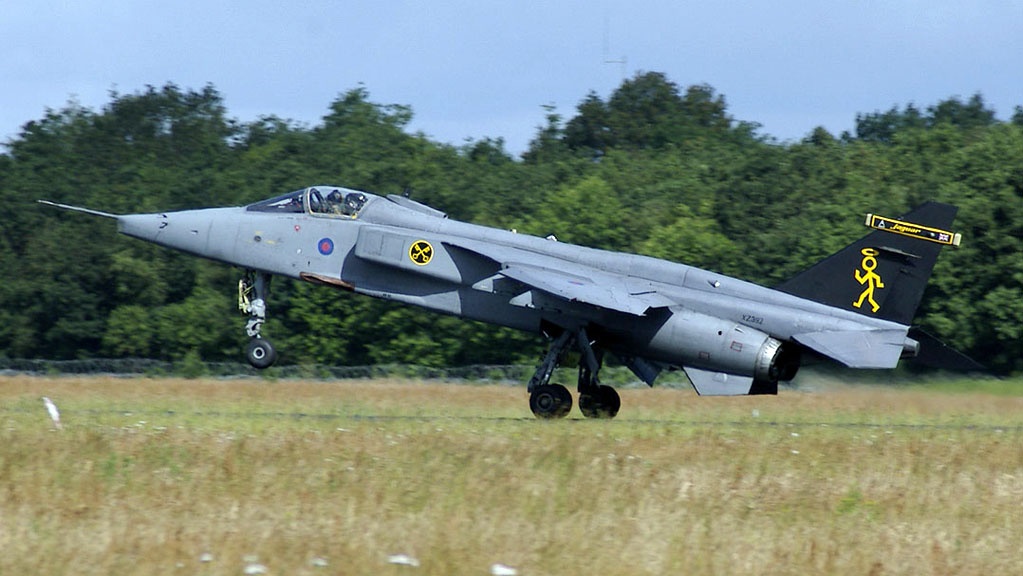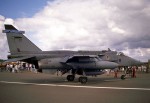
The SEPECAT Jaguar is an Anglo-French jet ground attack aircraft.
Developing nation: France and United Kingdom.
Manufacturer/designer: SEPECAT.
Production Lines: Velizy-Villacoublay France, Warton UK, Hindustan Aeronautics Limited (HAL) license produced Jaguars for the Indian Air Force.
Number built: 543.
Type aircraft: ground attack aircraft.
First flight:
- The first French Jaguar E (E-01) two-seat trainer prototype performed its initial flight on 8 September 1968, this also being the first flight of the Adour engine. Crashed on 26 March 1970.
- The first French Jaguar A single-seat strike variant prototype flew on 23 March 1969.
- The first French naval prototype, (M-05), flew at Istres on 14 November 1969
- The first RAF Jaguar S (XW560) single-seat strike variant prototype flew on 12 October 1969.
- The first RAF Jaguar B two-seat trainer variant prototype followed on 30 August 1971..
Retired: 2005 France, 2007 United Kingdom.
On 9 January 1968 the British and French governments signed a MOU on the Jaguar, with both countries committing to the purchase of 200 aircraft each. The British would obtain 110 Jaguar B trainers and 90 single-seat “Jaguar S (Strike)” strike fighters. The British turning almost 180 degrees from their original position by ordering 165 Jaguar S strike fighters and only 35 Jaguar B trainers. The Armée de L’Air would still obtain 75 Jaguar Es and 75 Jaguar As, but the French naval air arm, the Aeronavale, would obtain 10 Jaguar Es and 40 examples of a carrier-capable Jaguar single-seat strike variant, the “Jaguar M ((Marine)” cancelled in favor of the Dassault Super Etendard).
Dassault is responsible for the construction of the forward and centre fuselage, the forward fuel tanks and the undercarriage, while British Aerospace builds the rear fuselage, air inlets, wing and tail. In order to create the Jaguar, the original Breguet design had to be reworked, growing in length and being modified to use machined panels rather than the honeycomb construction originally proposed.
The RB.172 Adour afterburning turbofan was designed by Rolls-Royce and Turbomeca. Of modular design to ease maintenance, it is a two-spool design with a two-stage LP fan and five-stage HP compressor, both driven by single-stage turbines. The combustion chamber is annular with 18 fuel nozzles, while the afterburner is a compact but fully-modulated unit.
Britain and France developed their own avionics installations for Jaguar. The French opted for relative simplicity, while the RAF installed a more sophisticated system which has generally been adopted by export customers.
The RAF Jaguar GR.1 saw a lot of action in the Gulf War, painted desert pink and carrying overwing Sidewinder missiles. The Jaguar lacks one vital component, radar. It does however possess a computer system which allows waypoint co-ordinates to be entered before the start of the mission. Thereafter, a moving map display presents the aircraft’s projected position to the pilot, and this can be manually corrected as the mission proceeds.
Major upgrade came in year 2000, when Jaguar GR3 was presented. The upgrade included GPS, night vision goggles, helmet mounted sight, improved avionics and many more.
The Jaguar went on to see combat operations in several high-profile conflicts. British and French Jaguars operated in the 1991 Gulf War while British Jaguars took part in the upcoming Balkan Wars. French Jaguars served in the Kosovo War (1998-1999) while India fielded their Jaguars in the Kargil War (1999) against Pakistan. Ecuador unleashed their Jaguars in a limited role during the 1995 Cenepa War with Peru.
France retired their fleet of Jaguars in 2005 with the British following in 2007 after a defense budget review. For the French, the Jaguar was replaced by the Dassault Rafale multirole fighter. For the British, the Eurofighter Typhoon has replaced the Jaguar.
Variants
-
- Jaguar A – Single-seat all-weather tactical strike, ground-attack fighter version for the French Air Force, two prototypes and 160 production aircraft built.
- Jaguar T.Mk 2 – Two-seat training version for the Royal Air Force, one prototype and 38 production aircraft built.
- Jaguar T2A – Jaguar T2 upgrade similar to GR1A, 14 conversions from T2.
- Jaguar T2B – two Jaguar T2A aircraft given TIALD capability.
- Jaguar T4 – Jaguar T2A upgraded to Jaguar 96 standard.
- Jaguar E – two-seat training version for the French Air Force, two prototypes and 40 production aircraft built.
- Jaguar S / Jaguar GR1 – Single-seat all-weather tactical strike, ground-attack fighter version for the Royal Air Force, 165 built.
- Jaguar GR1A – Jaguar GR1 with navigation, chaff/flare, ECM and Sidewinder capability upgrades, 75 conversions from GR1.
- Jaguar GR.Mk 1B – Ten GR1 aircraft modified to carry TIALD pods.
- Jaguar GR3 – Jaguar 96 avionics upgrade to GR1A/B.
- Jaguar GR3A – Jaguar 97 avionics upgrade to GR3.
- Jaguar M – Single-seat naval strike prototype for the French Navy, one built.
- Jaguar Active Control Technology – One Jaguar converted into a research aircraft.
- Jaguar ES – Export version of the Jaguar S for the Ecuadorian Air Force, 10 built.
- Jaguar EB – Export version of the Jaguar B for the Ecuadorian Air Force, 2 built.
- Jaguar S(O) – Export version of the Jaguar S for the Royal Air Force of Oman, 20 built.
- Jaguar B(O) – Export version of the Jaguar B for the Royal Air Force of Oman, 4 built
- Jaguar IS – Single-seat all-weather tactical strike, ground-attack fighter for the Indian Air Force, 35 built by BAe and 99 built by HAL (Shamser).
- Jaguar IB – Two-seat training version for the Indian Air Force, three built by BAe and 29 built by HAL.
- Jaguar IM – Single-seat maritime anti-shipping aircraft for the Indian Air Force. Fitted with Agave radar and capable of carrying Sea Eagle anti-ship missile, 12 built.
- Jaguar SN – Export version of the Jaguar S for the Nigerian Air Force, 13 built.
- Jaguar BN – Export version of the Jaguar B for the Nigerian Air Force, 5 built.
Operators
All export Jaguar Internationals are based on the RAF’s Jaguar B/S airframe.
- Ecuador Air Force (10 single-seat, 2 two-seat)
- French Air Force (160 single-seat, 40 two-seat)
- Indian Air Force
- Nigerian Air Force (13 single-seat, 5 two-seat)
- Royal Air Force of Oman (20 single-seat, 4 two-seat)
- Royal Air Force (165 single-seat, 38 two-seat)
General characteristics
- Crew: One
- Length: 16.83 m (55 ft 3 in)
- Wingspan: 8.69 m (28 ft 6 in)
- Height: 4.92 m (16 ft 1 in)
- Wing area: 24 m² (258 ft²)
- Empty weight: 7,000 kg (15,400 lb)
- Loaded weight: 11,000 kg (24,250 lb)
- Max takeoff weight: 15,700 kg (34,600 lb)
- Powerplant: 2× Rolls-Royce/Turbomeca Adour Mk 102 turbofans, 32.5 kN (7,305 lbf) each
Performance
- Maximum speed: 1,593 km/h, 1055 mph (Mach 1.6)
- Range: 535 km (335 mi)
- Ferry range: 3,525 km (2,190 mi)
- Service ceiling: 14,000 m (46,000 ft)
- Thrust/weight: 0.60
Armament
- Guns: 2× 30 mm (1.18 in) ADEN cannons or DEFA cannons, 150 rounds/gun
- Hardpoints: 5 total: 4× under-wing and 1× center-line pylon stations with a capacity of 10,000 lb (4,500 kg) and provisions to carry combinations of:
- Rockets: 8× Matra rocket pods with 18× SNEB 68 mm rockets each
- Missiles: Anglo-French AS-37 Martel missiles
- Bombs: various
- Other: AN/ALQ-101 ECM protection pod (found only on RAF’s Jaguar GR.3/3A), Joint Reconnaissance Pod, external drop tanks for extended range/loitering time
- Missiles: 2× AIM-9 Sidewinders or Matra R550 Magics on overwing pylons (Jaguar International and RAF Jaguars only)
All pictures courtesy of Zijde Aviation Photo and Publishing, Rob Vogelaar



